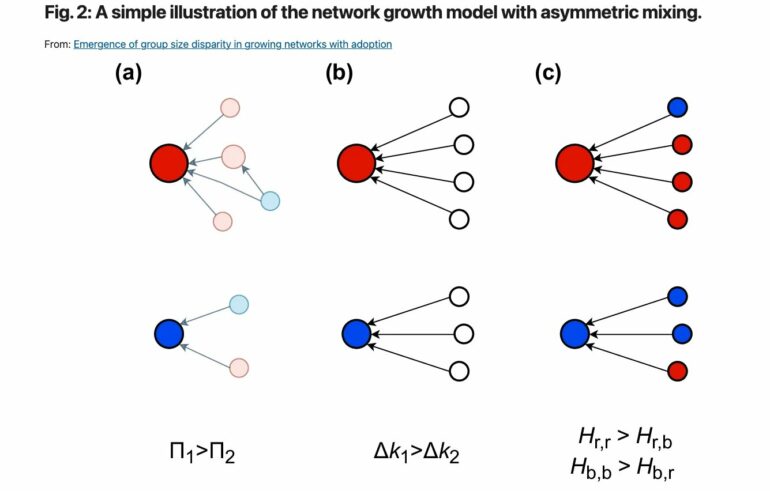As a physicist and data scientist with a keen interest in gender inequality, Fariba Karimi was amazed to discover that the gender gap in physics has remained almost unchanged since 1900. As the citation and coauthorship networks in physics expand, women still make up a small proportion—and the gaps between male and female are getting larger in terms of absolute numbers.
“With roughly the same number of men and women in the world, we should expect this gap to close in an equal society. But what we see in reality is a persistent gap in physics over time,” says Karimi, from the Complexity Science Hub.
“This gap was puzzling me. Why is this happening and when will this gap close?,” adds Karimi, also a professor at Graz University of Technology. Together with computer scientist Jun Sun, from the Leibniz Institute for the Social Sciences, Karimi decided to investigate why these inequities persist.
In a paper, titled “Emergence of group size disparity in growing networks with adoption,” published in Communications Physics, Karimi and Sun introduce a model that combines two key mechanisms—generalized preferential attachment and asymmetric mixing—to explain the enduring disparities observed in academic networks.
First, a look at real-world dynamics
Initially, the researchers constructed and examined the growing networks of citation and coauthorship in the American Physical Society (APS) publications. The APS dataset includes more than 668,000 papers published in APS journals between 1893 and 2020 and more than 8,5 million citations.
They observed that the ratios of male- to female-led papers, as well as male to female researchers, remain considerably high for decades, reflecting systematic disparities that can be associated to historical barriers of entry and social preferences.
“I was fascinated to see more and more female physicists, and more female-led papers in the field, which is good because we had a really large disparity before,” says Sun. “On the other hand, the gap in terms of absolute numbers was getting larger.”
Who takes in the newcomer?
Karimi and Sun decided to investigate these empirical findings further to uncover the reasons behind these disparities. “In real systems, it’s not as simple as someone coming and connecting to others in a network. Especially in systems like academia, it is also a matter of who takes in the newcomer and adopts him or her into their personal network. In our new model, we wanted to consider this adoption process,” explains Karimi.
“We combined two existing models into one,” adds Karimi. In the novel model, asymmetric mixing is the fundamental mechanism of adoption, as it reflects homophily, or the tendency that people who are alike act alike, that “birds of a feather naturally flock together.” A generalized preferential attachment growth mechanism is also incorporated into the model, where popular or established members attract more connections.
“We were able to replicate real-world dynamics with our model,” explains Karimi. Their model demonstrated, as the real-world data, the persistence of gender imbalances in citation and coauthorship trends.
“Our model shows that, if we continue collaborating and citing fellow physicists this way, this gap will remain as it is,” says Karimi.
“The novelty here is that we do not assume that the increase in women is an endogenous factor, but rather an emergent property of a time-dependent growing system. This explains why the gap persists,” explains Karimi.
What-if scenarios
“Our model shows that this slow arrival of women in physics is also related to biases that emerge when one decides to collaborate with a new person. Having an understanding of this mechanism allows us to discuss what-if scenarios,” adds the physicist.
“Theoretically, we could adjust the probability of adoption so that the number of women arriving will speed up and compensate, and they will have a similar adoption experience as men,” said Karimi. “If we don’t take these interventions soon, this gap will not close very easily because of this adoption process. It’s not just about having more women, but also about how they are integrating into networks.”
Implications for academia and beyond
While the study focuses on academic networks, its implications extend beyond academia. According to Karimi, the same network dynamics could also apply to various sectors, including corporate boards and managerial hiring practices, where biases and preferences can shape long-term growth and group representation.
Understanding the mechanisms behind these disparities could allow policymakers, organizations, and academic institutions to design interventions that promote more inclusive and equitable environments.
Creating opportunities for junior women and senior men to collaborate more is one way to promote collaboration equity, suggests Karimi.
“In the model, closing the gap is easily achieved by adjusting a couple of parameters. However, in reality such interventions are much more challenging, such as by giving female researchers more opportunities for funding, as well as promotion,” says Sun.
More information:
Jun Sun et al, Emergence of group size disparity in growing networks with adoption, Communications Physics (2024). DOI: 10.1038/s42005-024-01799-z
Provided by
Complexity Science Hub Vienna
Citation:
Why the gender gap in physics has been stable for more than a century (2024, September 26)



